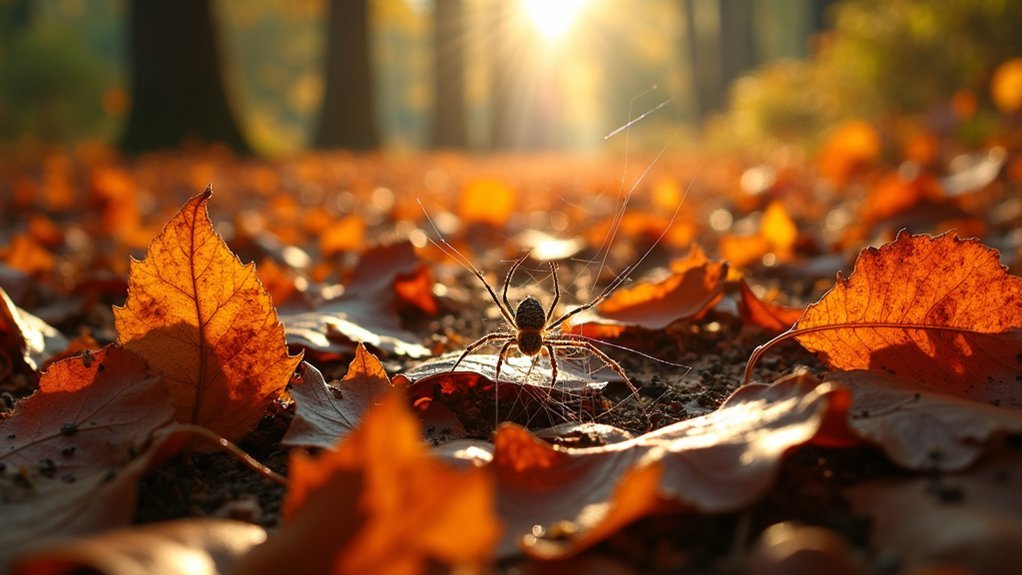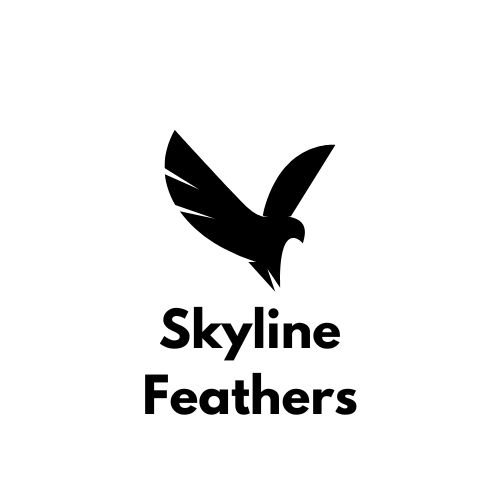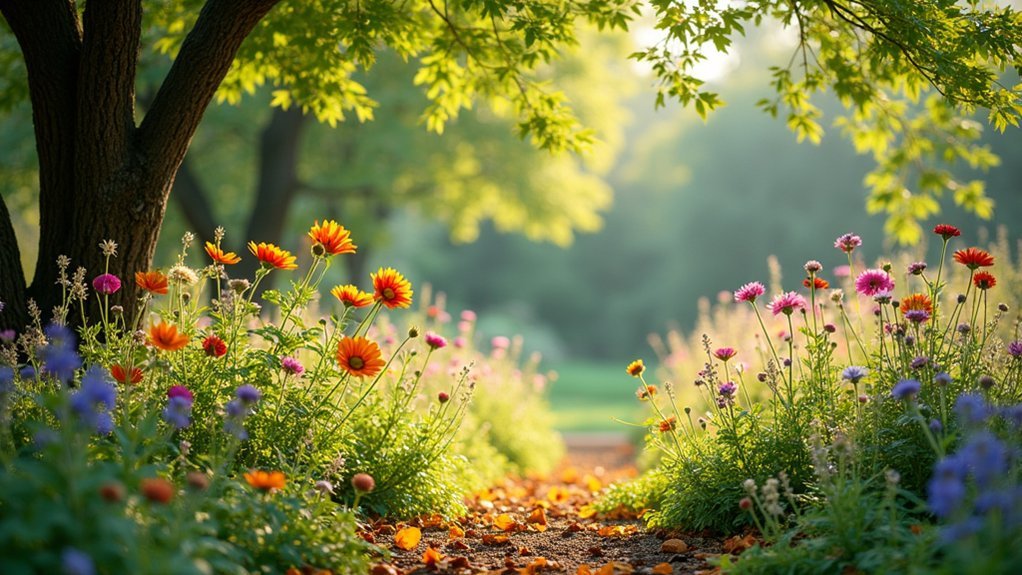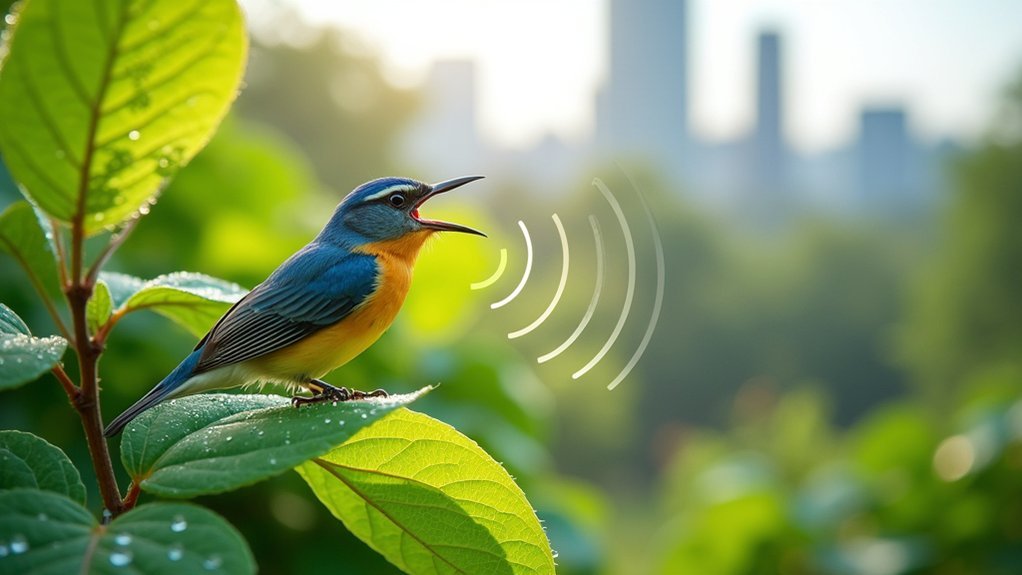Native gardens require strategic seasonal clean-up to balance habitat needs with garden aesthetics. You’ll help wildlife most by timing maintenance around natural cycles—waiting until soil temperatures reach 50°F and trees begin blooming. Leave seed heads intact through winter for bird food, maintain 2-3 inches of leaf litter in beds for insect habitat, and selectively prune to create structural diversity. These thoughtful approaches support entire ecosystems while keeping your garden healthy and vibrant throughout the seasons.
11 Second-Level Headings for “Why Native Gardens Need Seasonal Clean-Up For Wildlife”

When properly timed and thoughtfully executed, seasonal clean-up in native gardens plays an essential role in supporting wildlife throughout the year.
Your approach to garden maintenance directly impacts the habitat quality for native bees, butterflies, and other beneficial insects that rely on these spaces for survival.
By delaying your seasonal clean-up until late spring, you’re providing vital shelter for overwintering insects and food sources for birds during scarce winter months.
Watch for natural cues like blooming plum and apple trees to signal the right timing for your maintenance activities.
Remember that fallen leaves and decaying plant material aren’t just “mess”—they’re valuable organic matter that enriches your soil and supports biodiversity.
With strategic seasonal clean-up practices, you’ll create both an aesthetically pleasing garden and a thriving wildlife habitat that cycles nutrients naturally.
Timing Your Garden Maintenance to Support Urban Bird Populations
You’ll help urban birds thrive by strategically timing your garden cleanup to preserve essential winter resources.
Leaving seed heads from native plants like rudbeckias and asters intact through the colder months provides critical food when other sources are scarce.
Waiting until spring to cut back dead plant material guarantees birds have both shelter and nourishment during challenging winter conditions.
Optimal Cleanup Timing
The timing of your native garden cleanup directly impacts local bird populations and their seasonal feeding patterns.
Your garden’s maintenance schedule should align with natural cycles, particularly when you’re aiming to support native insects and birds in urban environments.
For ideal cleanup timing, consider these key factors:
- Wait until apple and pear trees bloom (mid-April to mid-May) when native bees emerge and need habitat support.
- Delay garden cleanup until soil temperatures reach 50°F, ensuring beneficial insects have completed their life cycles.
- Participate in “No Mow May” by postponing mowing until early June, creating essential habitat for early-season pollinators.
Seed-Head Preservation Benefits
Beyond ideal timing considerations lies a significant yet often overlooked practice: preserving seed heads in your native garden.
When you leave dried seed heads from rudbeckias and asters standing through winter, you’re providing essential nourishment for finches, sparrows, and other urban birds during food-scarce periods.
This simple act creates a winter buffet that supports bird populations when they need it most.
You’ll also protect beneficial insects and hibernating pollinators who use these plant structures as shelter until spring arrives.
Don’t rush to tidy up after the growing season ends.
By waiting until after the final frost to remove seed heads, you’re maintaining both food sources and habitat continuity.
Your patience transforms your garden into a wildlife sanctuary while creating an aesthetically pleasing winter landscape that celebrates nature’s complete lifecycle.
Creating Structural Diversity Through Strategic Pruning

Three key principles guide effective pruning in native gardens: height variation, density management, and selective thinning.
When you strategically prune your native plants, you’re creating structural diversity that attracts a wider range of wildlife visitors.
Maintain these practices for a thriving ecosystem:
- Keep perennial plants at varying heights (at least 18 inches) to provide shelter for overwintering insects and small mammals.
- Thin out overly dense areas to improve air circulation while maintaining enough cover for nesting wildlife.
- Remove only dead or damaged branches to preserve the natural appearance while enhancing garden complexity.
Preserving Winter Seed Heads for Foraging Birds
While strategic pruning creates structural diversity throughout your garden, maintaining seed heads serves a different purpose in your winter landscape.
When you preserve seed heads from native plants like rudbeckias and asters, you’re providing critical food sources for birds during the leanest months of the year.
Goldfinches, sparrows, and other local birds depend on these seeds to survive harsh winter conditions when other food becomes scarce.
By resisting the urge to cut back these plants in fall, you’re creating a natural feeding station that supports bird nutrition and population health.
This approach does double duty—the dried seed heads add visual interest to your winter garden while creating habitat for beneficial insects.
You’ll enjoy both the beauty of foraging birds and the ecological benefits of your thoughtful garden maintenance.
Managing Leaf Litter as Critical Habitat for Beneficial Insects

Preserving leaf litter in your garden creates essential microclimates where butterflies, native bees, and other beneficial insects can safely overwinter.
As these leaves break down, they’ll feed your garden’s ecosystem by releasing nutrients and creating rich soil that supports plant health.
Instead of removing all fallen leaves, strategically maintain leaf layers in beds and under shrubs while keeping them off lawns and away from building foundations.
Microclimates for Overwintering Species
Leaf litter transforms your garden into a winter sanctuary for countless beneficial insects. Those 2-3 inches of fallen leaves create essential microclimates that maintain consistent soil temperature and moisture levels throughout harsh winter conditions.
You’re fundamentally providing overwintering species with their ideal habitat.
When you preserve leaf litter, you’re supporting:
- Native bees and butterflies in chrysalides that depend on this natural insulation for survival
- Beneficial invertebrates that utilize the decomposing material as both shelter and food source
- Diverse ecosystems that enhance soil health while naturally cycling nutrients
These microclimates serve as nature’s protection system, allowing various species to survive until spring.
Decomposition Feeds Ecosystems
The seemingly simple process of decomposition creates an intricate food web right in your garden. When you allow leaf litter to remain, you’re supporting countless beneficial insects that depend on this organic material during winter months. Butterflies, native bees, and fireflies all utilize this natural shelter for nesting and protection.
| Leaf Litter Benefits | Ecosystem Impact |
|---|---|
| Natural mulch | Retains soil moisture |
| Nutrient cycling | Enriches soil for spring growth |
| Overwintering habitat | Increases pollinator survival |
As decomposition progresses, nutrients release slowly into your soil, feeding microorganisms that further break down organic material. This natural cycle eliminates the need for chemical fertilizers while boosting your garden’s biodiversity. You’ll notice healthier plants and more wildlife activity when you preserve these critical habitat layers rather than removing them completely during fall cleanup.
Strategic Leaf Preservation
While many gardeners rush to rake every fallen leaf from their property, a thoughtful approach to leaf management creates vital sanctuaries for beneficial insects.
A moderate layer of leaf litter—about 2-3 inches deep—provides essential habitat for native bees, butterfly chrysalides, and other pollinators that need protection during winter months.
You’ll support biodiversity and garden health when you:
- Leave leaf litter in garden beds to insulate soil and regulate moisture
- Create designated “messy corners” where leaves remain undisturbed year-round
- Avoid blowing or raking areas where overwintering insects might shelter
This strategic preservation nurtures the microorganisms and fungi that break down organic matter into nutrients your plants need.
Balancing Clean-Up With Wildlife Shelter Needs

As gardeners race to tidy their outdoor spaces before winter, they might inadvertently destroy essential habitats that native wildlife depends on for survival. Your garden cleanup timing can greatly impact native bees and other beneficial creatures that need shelter to survive the cold months.
| Garden Area | Clean Now | Wait Until Spring |
|---|---|---|
| Flower beds | Remove diseased material | Leave seed heads and stems |
| Leaf litter | Clear walkways only | Preserve in beds and borders |
| Bare soil patches | Maintain some areas | Don’t mulch completely |
| Tree/shrub bases | Minimal grooming | Leave fallen organic matter |
| Dead stems | Remove broken ones | Keep upright stems until after apple blossom |
You’ll create a healthier ecosystem by timing your cleanup with nature’s calendar rather than your own. Watch for apple and pear blooms as signals before removing last season’s refuge.
Seasonal Bird Species and Their Specific Garden Requirements
In your native garden, you’ll notice different bird species have unique requirements that change with the seasons.
Migratory birds like warblers and thrushes seek specific native shrubs for nesting materials in spring and summer, while seed-eaters such as goldfinches rely on your uncut sunflowers and grasses during fall and winter.
These seasonal patterns should guide your garden maintenance decisions, as leaving some areas untouched provides the food sources and shelter that birds need throughout their annual cycles.
Migratory Nesting Preferences
When spring arrives, your garden can become an essential sanctuary for returning migratory birds seeking nesting sites. Different species have distinct preferences that you’ll want to accommodate through thoughtful garden design and maintenance.
- Eastern Bluebirds prefer open areas with low vegetation, while American Robins seek the shelter of shrubs and trees—structural diversity is key.
- Warblers and thrushes gravitate toward gardens with diverse native plantings that provide abundant food sources during nesting season.
- Indigo Buntings rely on specific native plants for nesting materials, so leave some dead stems and plant debris during your clean-up routine.
Seasonal Feeding Patterns
Seasonal bird visitors transform your native garden into a dynamic ecosystem with changing nutritional needs throughout the year. Goldfinches and juncos depend on your native garden for seeds and insects during migration and breeding, requiring thoughtful maintenance to guarantee food availability when they arrive.
You’ll notice chickadees and nuthatches foraging differently as seasons change, seeking both evergreen and deciduous trees for their seasonal feeding patterns.
During winter, these birds rely heavily on seed heads and hollow stems you’ve preserved during fall clean-up.
When spring migrants return, they’re counting on your garden’s blooming native plants. By timing your garden maintenance to preserve these resources, you’re supporting birds’ seasonal feeding cycles.
Remember that your clean-up practices directly impact whether birds find the nourishment they need throughout their annual lifecycle.
Supporting Nesting Materials Through Selective Trimming

Though many gardeners rush to clear away plant debris in early spring, strategic trimming practices can transform your native garden into a wildlife nursery.
When you time your trimming to coincide with apple and pear tree blooms, you’ll provide habitat exactly when pollinators need it most.
Native plants provide essential resources when you:
- Leave hollow stems standing for solitary bees to nest inside
- Selectively trim back certain areas while preserving seed heads that feed overwintering birds
- Maintain native grasses until late spring to shelter emerging pollinators from unexpected frosts
Native Plant Deadheading: When and Why It Matters for Birds
The delicate balance between garden maintenance and wildlife support hinges on your deadheading practices. While removing spent blooms from native plants can trigger a second flowering that feeds pollinators, strategic timing maximizes benefits for local wildlife.
Consider postponing deadheading until seeds have fully developed. Coneflowers and sunflowers provide essential nutrition for finches and sparrows during fall and winter months. You’ll support bird survival by leaving these seed heads intact when temperatures drop.
When you do deadhead, focus on species that will produce additional blooms rather than those prized by seed-eating birds. This selective approach maintains your garden’s appearance while creating a sustainable food source.
Water Features: Maintenance Practices for Year-Round Bird Access
Just as native plants provide food for our feathered friends, water features offer essential hydration and bathing opportunities throughout the year.
Maintaining these wildlife magnets requires consistent attention to guarantee they remain inviting and safe.
Wildlife water features demand regular care to remain welcoming havens for your garden visitors.
Regular maintenance keeps your water features functioning effectively:
- Clean debris and algae regularly to prevent contamination that deters birds
- Maintain consistent water levels, especially during dry periods, using submersible pumps or rainwater collection systems
- Add aeration through fountains or bubblers to keep water fresh and prevent mosquito breeding
Don’t forget to incorporate shallow areas or ledges in your pond design, creating safe access points for smaller birds.
Your diligence will reward you with year-round wildlife visitors that add movement, color, and song to your native garden sanctuary.
Protection Strategies for Overwintering Chrysalides and Cocoons
While many gardeners enthusiastically anticipate spring cleanup, hidden treasures lie dormant throughout your native garden during winter months. Overwintering chrysalides and cocoons depend on your thoughtful timing for their survival. Wait until local fruit trees bloom before removing fallen leaves and plant debris where these delicate structures are camouflaged.
| Timing Guideline | What to Protect | Benefits |
|---|---|---|
| After apple bloom | Fallen leaves | Butterfly habitat |
| Mid-spring | Dead stems | Moth cocoons |
| When temps reach 50°F | Plant debris | Emergence success |
| After 5+ warm days | Leaf litter | Complete metamorphosis |
| Local bloom indicators | Edge habitats | Increased biodiversity |
Frequently Asked Questions
Why Is It Important to Conserve Native Plants?
You’ll conserve biodiversity when you grow native plants. They support local wildlife, require less water and maintenance, enhance ecosystem services, and build resilience against climate change in your region’s natural environment.
When to Clean up a Yard for Pollinators?
You’ll want to delay yard cleanup until after local flowering events, like plum and apple blossoms. Wait through winter and early spring, following “No Mow May” principles to protect emerging bees and other essential pollinators.
How Do Native Plants Benefit Wildlife?
Your native plants feed and shelter wildlife throughout the year. They’ve evolved to support local insects, birds, and mammals, providing essential food sources and habitats that non-native species simply can’t match.
When to Start Spring Garden Clean Up?
Wait until mid to late April for spring cleanup. You’ll know it’s time when apple blossoms fade and soil reaches 50°F. Consider participating in “No Mow May” to protect emerging pollinators in your garden.
In Summary
When you maintain your native garden with wildlife in mind, you’re creating a sanctuary that serves countless species. Remember, it’s all about balance—clean enough to prevent disease but wild enough to provide food and shelter year-round. By timing your efforts with natural cycles, you’ll foster a thriving ecosystem that supports birds, insects, and other wildlife right in your backyard.





Leave a Reply